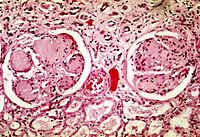
Photo from wikipedia
Metabolic imbalance in chronic diseases such as type-1 diabetes may lead to detectable perturbations in the molecular composition of residual skin surface components (RSSC). This study compared the accumulation rate… Click to show full abstract
Metabolic imbalance in chronic diseases such as type-1 diabetes may lead to detectable perturbations in the molecular composition of residual skin surface components (RSSC). This study compared the accumulation rate and the composition of RSSC in type-1 diabetic patients with those in matched controls in order to identify potential biomarkers of the disease. Samples of RSSC were collected from the foreheads of type-1 diabetic (n = 55) and non-diabetic (n = 58) volunteers. Samples were subsequently analysed to identify individual components (sebomic analysis). There was no significant difference in the rate of accumulation of RSSC between type-1 diabetics and controls. In terms of molecular composition, 171 RSSC components were common to both groups, 27 were more common in non-diabetics and 18 were more common in type-1 diabetic patients. Statistically significant (P < 0.05) differences between diabetic and non-diabetic volunteers were observed in the recovered amounts of one diacylglyceride (m/z 594), six triacylglycerides (m/z 726–860) and six free fatty acids (m/z 271–345). These findings indicate that sebomic analysis can identify differences in the molecular composition of RSSC components between type-1 diabetic and non-diabetic individuals. Further work is required to determine the practical utility and identity of these potential biomarkers.
Journal Title: Scientific Reports
Year Published: 2017
Link to full text (if available)
Share on Social Media: Sign Up to like & get
recommendations!